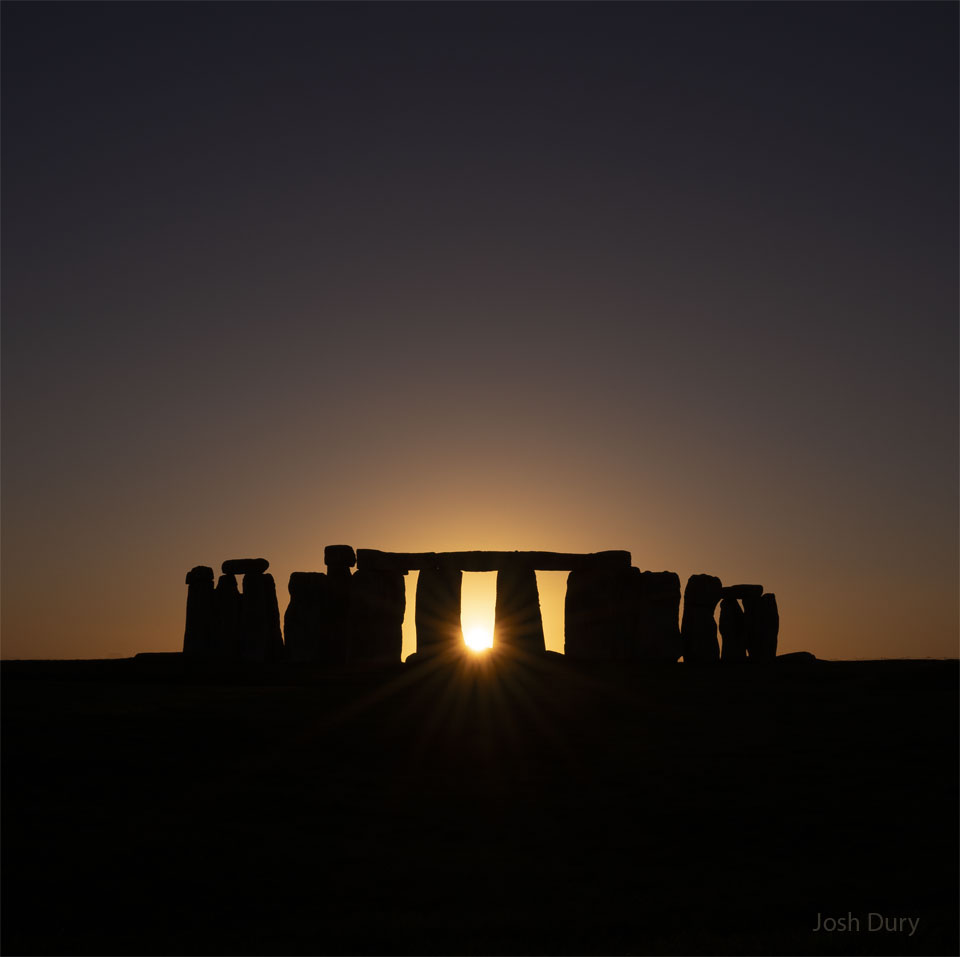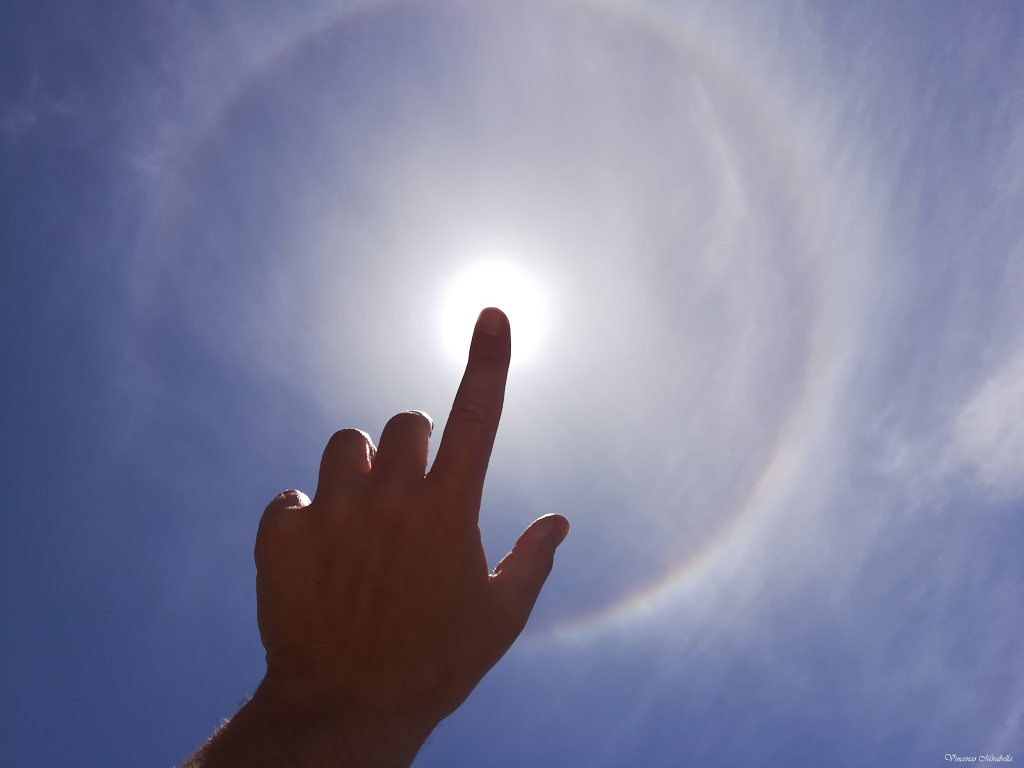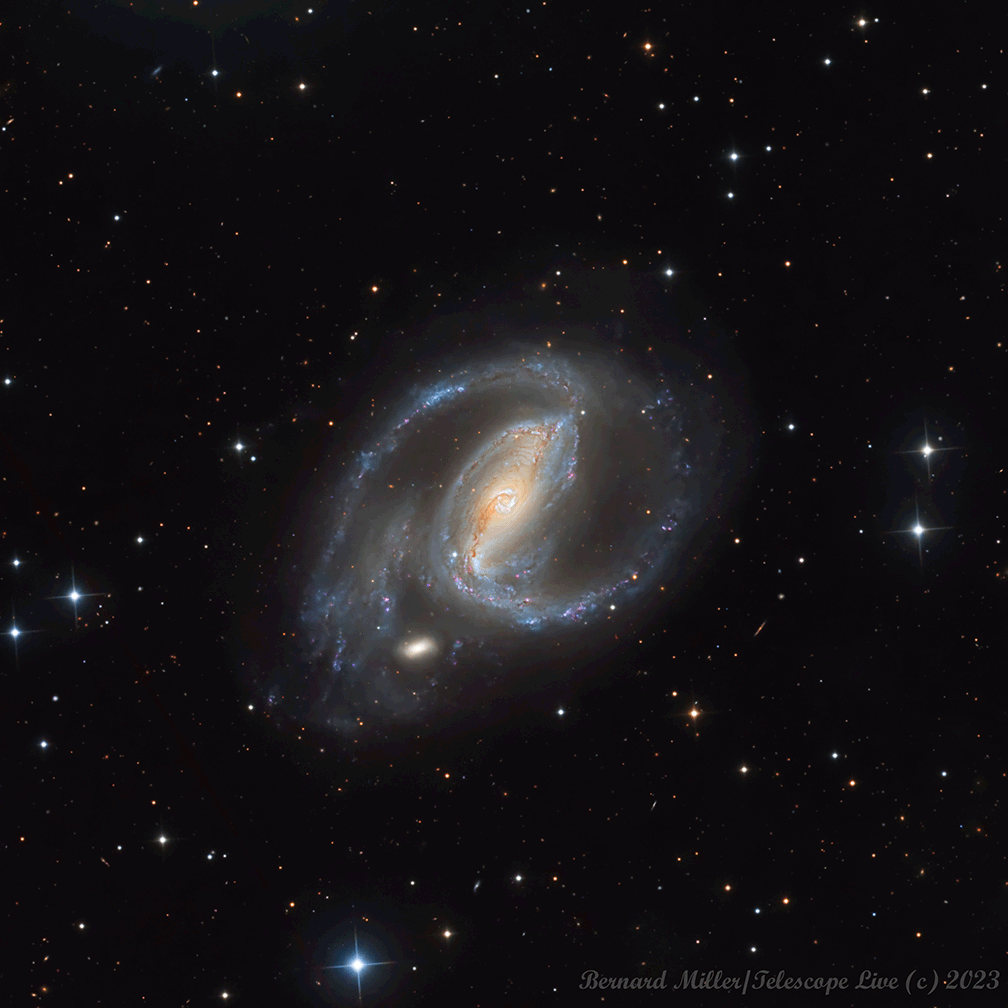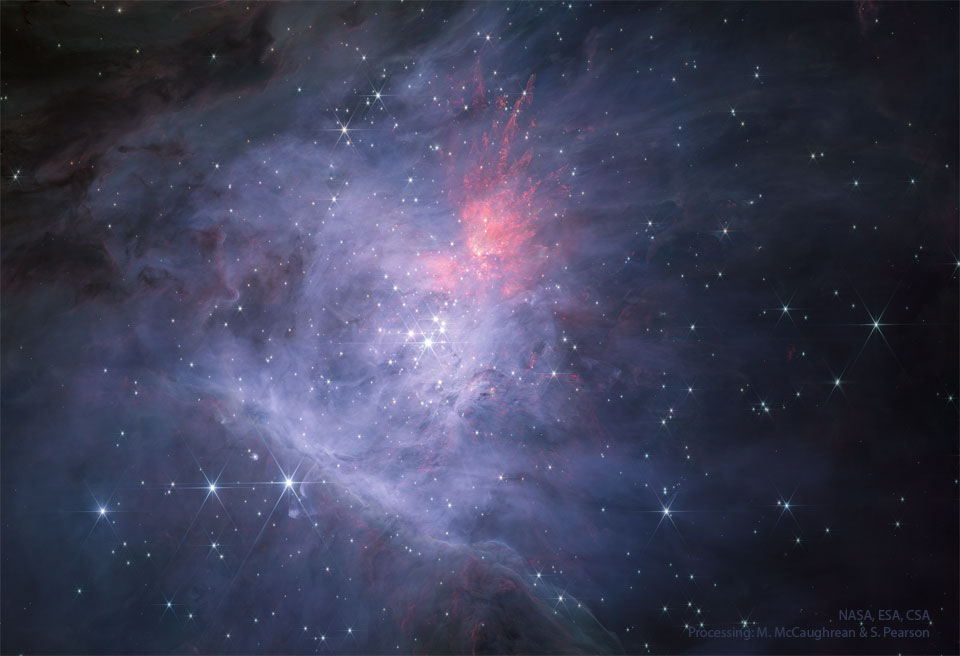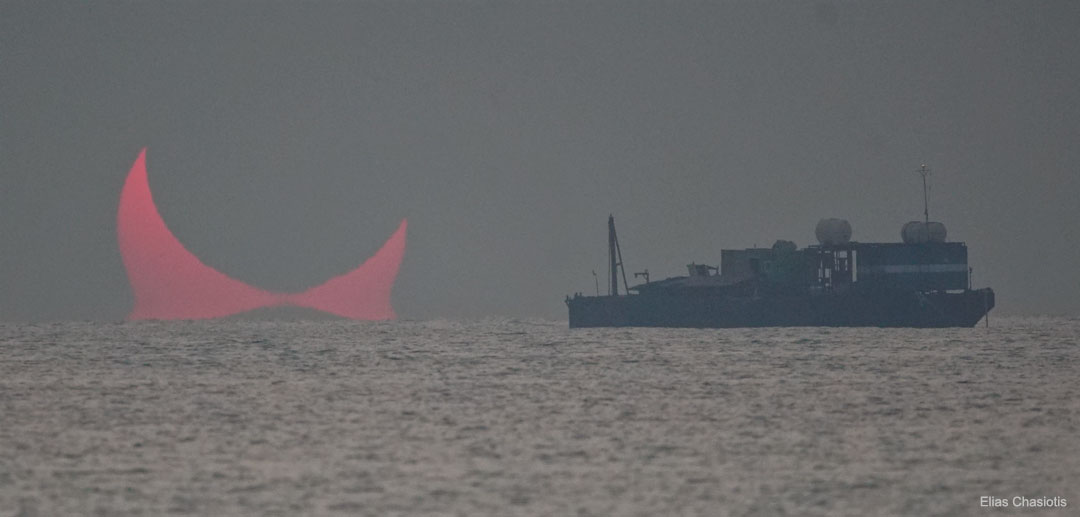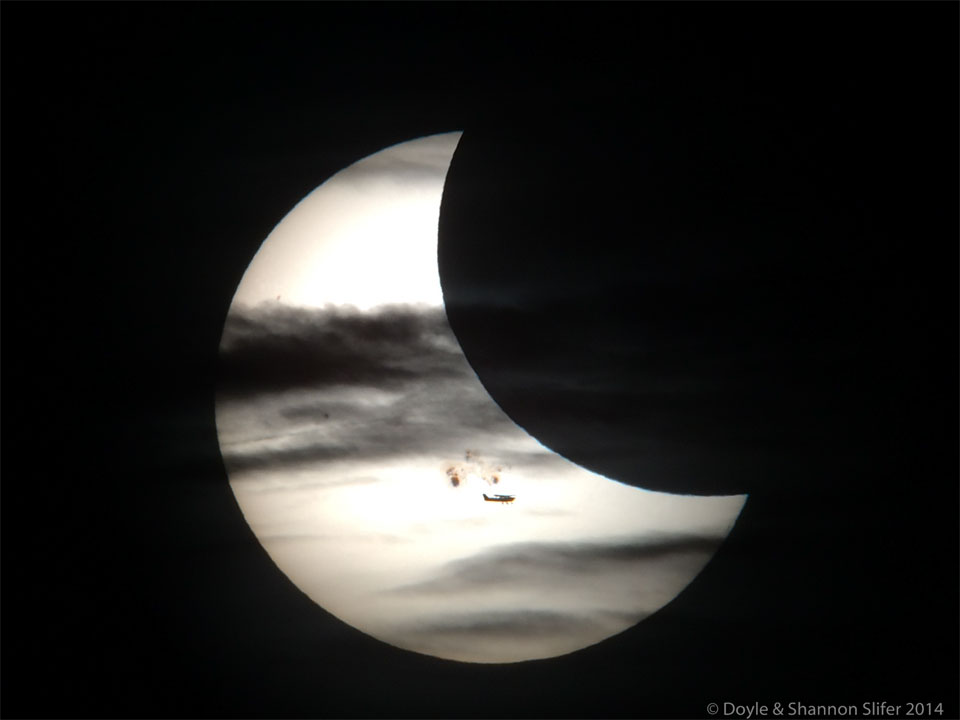Η Αστρονομική Εικόνα της Ημέρας από τη NASA
Sunset Solstice over Stonehenge
22/12/2025
Yesterday the Sun reached its southernmost point in planet Earth's sky. Called a solstice, many cultures mark yesterday's date as a change of seasons -- from autumn to winter in Earth's Northern Hemisphere and from spring to summer in Earth's Southern Hemisphere. The featured image was taken just before the longest night of the 2025 northern year at Stonehenge in United Kingdom. There, through stones precisely placed 4,500 years ago, a 4.5 billion year old large glowing orb is seen setting. Even given the precession of the Earth's rotational axis over the millennia, the Sun continues to set over Stonehenge in an astronomically significant way.
Copyright: English Heritage, Josh Dury
Προηγούμενες Αστρονομικές Εικόνες της Ημέρας από τη NASA
Circular Sun Halo
14/10/2023
Want to see a ring around the Sun? It's easy to do in daytime skies around the world. Created by randomly oriented ice crystals in thin high cirrus clouds, circular 22 degree halos are visible much more often than rainbows. This one was captured by smart phone photography on May 29, 2021 near Rome, Italy. Carefully blocking the Sun, for example with a finger tip, is usually all that it takes to reveal the common bright halo ring. The halo's characteristic angular radius is about equal to the span of your hand, thumb to little finger, at the end of your outstretched arm. Want to see a ring of fire eclipse? That's harder. The spectacular annular phase of today's (October 14) solar eclipse, known as a ring of fire, is briefly visible only when standing along the Moon's narrow shadow track that passes over limited parts of North, Central, and South America. The solar eclipse is partial though, when seen from broader regions throughout the Americas. Album growing: Selected eclipse images sent in to APOD
Copyright: Vincenzo Mirabella
Hydrogen Clouds of M33
13/10/2023
Gorgeous spiral galaxy Messier 33 seems to have more than its fair share of glowing hydrogen gas. A prominent member of the local group of galaxies, M33 is also known as the Triangulum Galaxy and lies a mere 3 million light-years away. The galaxy's central 30,000 light-years or so are shown in this sharp galaxy portrait. The portrait features M33's reddish ionized hydrogen clouds or HII regions. Sprawling along loose spiral arms that wind toward the core, M33's giant HII regions are some of the largest known stellar nurseries, sites of the formation of short-lived but very massive stars. Intense ultraviolet radiation from the luminous, massive stars ionizes the surrounding hydrogen gas and ultimately produces the characteristic red glow. In this image, broadband data were combined with narrowband data recorded through a hydrogen-alpha filter. That filter transmits the light of the strongest visible hydrogen emission line.
Copyright: Reinhold Wittich
Mu Cephei
12/10/2023
Mu Cephei is a very large star. An M-class supergiant some 1500 times the size of the Sun, it is one of the largest stars visible to the unaided eye, and even one of the largest in the entire Galaxy. If it replaced the Sun in our fair Solar System, Mu Cephei would easily engulf Mars and Jupiter. Historically known as Herschel's Garnet Star, Mu Cephei is extremely red. Approximately 2800 light-years distant, the supergiant is seen near the edge of reddish emission nebula IC 1396 toward the royal northern constellation Cepheus in this telescopic view. Much cooler and hence redder than the Sun, this supergiant's light is further reddened by absorption and scattering due to intervening dust within the Milky Way. A well-studied variable star understood to be in a late phase of stellar evolution, Mu Cephei is a massive star too, destined to ultimately explode as a core-collapse supernova.
Copyright: David Cruz
NGC 1097: Spiral Galaxy with Supernova
11/10/2023
What's happening in the lower arm of this spiral galaxy? A supernova. Last month, supernova SN 2023rve was discovered with UAE's Al-Khatim Observatory and later found to be consistent with the death explosion of a massive star, possibly leaving behind a black hole. Spiral galaxy NGC 1097 is a relatively close 45 million light years away and visible with a small telescope toward the southern constellation of the Furnace (Fornax). The galaxy is notable not only for its picturesque spiral arms, but also for faint jets consistent with ancient star streams left over from a galactic collision -- possibly with the small galaxy seen between its arms on the lower left. The featured image highlights the new supernova by blinking between two exposures taken several months apart. Finding supernovas in nearby galaxies can be important in determining the scale and expansion rate of our entire universe -- a topic currently of unexpected tension and much debate. APOD editor to speak: in Houghton, Michigan on Thursday, October 12 at 6 pm
Copyright: NASA
Hidden Orion from Webb
10/10/2023
The Great Nebula in Orion has hidden stars. To the unaided eye in visible light, it appears as a small fuzzy patch in the constellation of Orion. But this image was taken by the Webb Space Telescope in a representative-color composite of red and very near infrared light. It confirms with impressive detail that the Orion Nebula is a busy neighborhood of young stars, hot gas, and dark dust. The rollover image shows the same image in representative colors further into the near infrared. The power behind much of the Orion Nebula (M42) is the Trapezium - a cluster of bright stars near the nebula's center. The diffuse and filamentary glow surrounding the bright stars is mostly heated interstellar dust. Detailed inspection of these images shows an unexpectedly large number of Jupiter-Mass Binary Objects (JuMBOs), pairs of Jupiter-mass objects which might give a clue to how stars are forming. The whole Orion Nebula cloud complex, which includes the Horsehead Nebula, will slowly disperse over the next few million years. APOD editor to speak: in Houghton, Michigan on Thursday, October 12 at 6 pm
Copyright: NASA
A Distorted Sunrise Eclipse
09/10/2023
Yes, but have you ever seen a sunrise like this? Here, after initial cloudiness, the Sun appeared to rise in two pieces and during a partial eclipse in 2019, causing the photographer to describe it as the most stunning sunrise of his life. The dark circle near the top of the atmospherically-reddened Sun is the Moon -- but so is the dark peak just below it. This is because along the way, the Earth's atmosphere had a layer of unusually warm air over the sea which acted like a gigantic lens and created a second image. For a normal sunrise or sunset, this rare phenomenon of atmospheric optics is known as the Etruscan vase effect. The featured picture was captured in December 2019 from Al Wakrah, Qatar. Some observers in a narrow band of Earth to the east were able to see a full annular solar eclipse -- where the Moon appears completely surrounded by the background Sun in a ring of fire. The next solar eclipse, also an annular eclipse for well-placed observers, will occur this coming Saturday. APOD editor to speak: in Houghton, Michigan on Thursday, October 12 at 6 pm
Copyright: Elias Chasiotis
Plane, Clouds, Moon, Spots, Sun
08/10/2023
What's that in front of the Sun? The closest object is an airplane, visible just below the Sun's center and caught purely by chance. Next out are numerous clouds in Earth's atmosphere, creating a series of darkened horizontal streaks. Farther out is Earth's Moon, seen as the large dark circular bite on the upper right. Just above the airplane and just below the Sun's surface are sunspots. The main sunspot group captured here, AR 2192, was in 2014 one of the largest ever recorded and had been crackling and bursting with flares since it came around the edge of the Sun a week before. This show of solar silhouettes was unfortunately short-lived. Within a few seconds the plane flew away. Within a few minutes the clouds drifted off. Within a few hours the partial solar eclipse of the Sun by the Moon was over. Fortunately, when it comes to the Sun, even unexpected alignments are surprisingly frequent. Perhaps one will be imaged this Saturday when a new partial solar eclipse will be visible from much of North and South America. APOD editor to speak: in Houghton, Michigan on Thursday, October 12 at 6 pm
Copyright: Doyle and Shannon Slifer
The Once and Future Stars of Andromeda
07/10/2023
This picture of Andromeda shows not only where stars are now, but where stars will be. The big, beautiful Andromeda Galaxy, M31, is a spiral galaxy a mere 2.5 million light-years away. Image data from space-based and ground-based observatories have been combined here to produce this intriguing composite view of Andromeda at wavelengths both inside and outside normally visible light. The visible light shows where M31's stars are now, highlighted in white and blue hues and imaged by the Hubble, Subaru, and Mayall telescopes. The infrared light shows where M31's future stars will soon form, highlighted in orange hues and imaged by NASA's Spitzer Space Telescope. The infrared light tracks enormous lanes of dust, warmed by stars, sweeping along Andromeda's spiral arms. This dust is a tracer of the galaxy's vast interstellar gas, raw material for future star formation. Of course, the new stars will likely form over the next hundred million years or so. That's well before Andromeda merges with our Milky Way Galaxy in about 5 billion years.
Copyright: NASA
Η Αστρονομική Εικόνα της Ημέρας από τη NASA (NASA Astronomy Picture of the Day) είναι μια δωρεάν υπηρεσία που παρέχει καθημερινά μια εντυπωσιακή εικόνα από το σύμπαν, την λήψη της οποίας έχει πραγματοποιήσει κάποιος από τους αστρονόμους της NASA ή από κάποιον από τους δορυφόρους ή τα τηλεσκόπια που η NASA λειτουργεί. Οι εικόνες που εμφανίζονται καλύπτουν μια ευρεία γκάμα από θέματα, συμπεριλαμβανομένων των αστερισμών, των γαλαξιών, των πλανητικών συστημάτων, των κομητών, των αστρικών σωμάτων και των παρατηρητηρίων. Κάθε εικόνα συνοδεύεται από μια σύντομη εξήγηση και πληροφορίες σχετικά με το τι παρατηρείται στην εικόνα.
